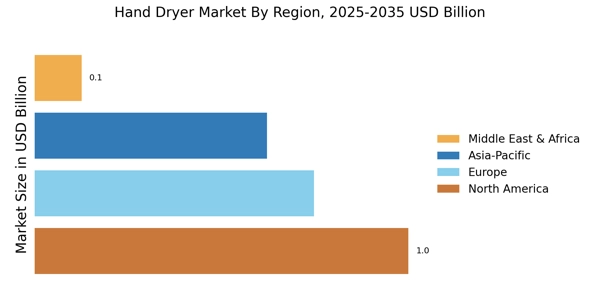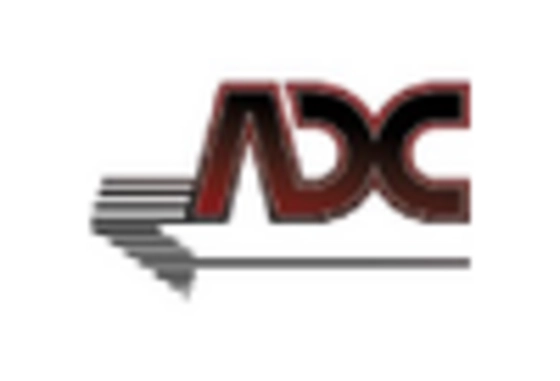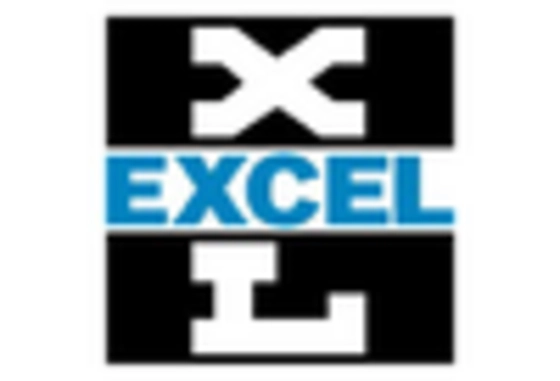Cost-Effectiveness
The Hand Dryer Market benefits from the cost-effectiveness of hand dryers compared to traditional paper towel dispensers. Businesses are increasingly recognizing the long-term savings associated with hand dryers, which eliminate the need for constant paper towel replenishment and disposal. Studies indicate that the operational costs of hand dryers can be significantly lower, with some estimates suggesting savings of up to 90% over time. This financial incentive is particularly appealing to facilities with high foot traffic, such as airports and shopping malls, where the demand for hand drying solutions is substantial. As organizations seek to optimize their operational budgets, the Hand Dryer Market is likely to see a rise in adoption rates, driven by the clear economic advantages of hand dryers.
Regulatory Compliance
The Hand Dryer Market is influenced by increasing regulatory compliance regarding hygiene and environmental standards. Governments and health organizations are implementing stricter regulations aimed at promoting sanitary practices in public spaces. These regulations often encourage the use of hand dryers as a means to improve hygiene and reduce waste associated with paper towels. Compliance with these standards is becoming essential for businesses, particularly in sectors such as food service and healthcare, where hygiene is critical. As a result, the demand for hand dryers is expected to rise as organizations strive to meet regulatory requirements. This trend indicates a robust future for the Hand Dryer Market, as compliance drives investment in modern hand drying solutions.
Sustainability Initiatives
The Hand Dryer Market is increasingly influenced by sustainability initiatives as businesses and consumers alike prioritize eco-friendly solutions. The shift towards reducing paper waste has led to a growing preference for hand dryers, which are perceived as a more sustainable option. According to recent data, hand dryers can reduce paper towel waste by up to 90%, contributing to lower landfill contributions. Furthermore, advancements in energy-efficient technology have made modern hand dryers more appealing, as they consume less electricity compared to older models. This trend aligns with the broader movement towards corporate social responsibility, where companies seek to enhance their environmental credentials. As a result, the Hand Dryer Market is likely to see continued growth driven by the demand for sustainable products that align with consumer values.
Technological Advancements
The Hand Dryer Market is significantly impacted by rapid technological advancements that enhance product efficiency and user experience. Innovations such as high-speed hand dryers, which can dry hands in under 10 seconds, are gaining traction among consumers and businesses. These models not only improve user satisfaction but also reduce energy consumption, making them more cost-effective in the long run. Additionally, the integration of smart technology, such as sensors and app connectivity, is becoming more prevalent, allowing for better monitoring and maintenance of hand dryer units. As these technologies evolve, they are likely to attract more customers, thereby expanding the Hand Dryer Market. The continuous improvement in design and functionality suggests a promising future for hand dryer manufacturers.
Health and Hygiene Awareness
The Hand Dryer Market is experiencing a surge in demand due to heightened health and hygiene awareness. In various sectors, including healthcare, education, and hospitality, the emphasis on maintaining cleanliness has become paramount. Hand dryers, particularly touchless models, are viewed as a hygienic alternative to traditional paper towels, which can harbor bacteria. Research indicates that touchless hand dryers can reduce the spread of germs, making them a preferred choice in public restrooms. This increased focus on hygiene is likely to drive the adoption of hand dryers, as facilities aim to provide safer environments for their patrons. Consequently, the Hand Dryer Market is poised for growth as organizations invest in solutions that enhance hygiene and promote public health.


















Leave a Comment